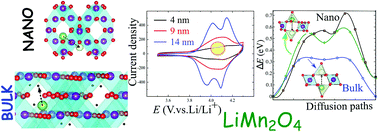Understanding the loss of electrochemical activity of nanosized LiMn2O4 particles: a combined experimental and ab initio DFT study
Abstract
In the field of Li-ion batteries (LIBs), one prevalent expectation is that smaller sized electrode materials lead to better battery performances. Here, we show that this reasoning fails for nanoparticles of LiMn2O4 (LMO) below a certain critical average size. For this, using a microwave-assisted hydrothermal methodology and heat treatment, we obtained spinel LMO nanoparticles with genuinely small average sizes (4, 9, and 14 nm). When the performance of these LMOs for the Li-ion extraction/insertion processes was assessed by voltammetry and impedance spectroscopy, contrary to expectations, the decrease of the nanoparticle size caused a progressive hindrance of these processes. Using an ab initio DFT methodology, this phenomenon could be accounted for with a theoretical explanation for the significantly decreased electrochemical activity of the smallest LMO nanoparticles. We found that the redox voltage associated with the Li-ion insertion process becomes significantly higher as the average size of the nanoparticles decreases from 14 to 1.3 nm, changing from 3.93 to 4.64 V, thus hindering the process. We could also show that the redox voltage increase is due to a consequent significant increase of the energy barrier for Li-ion diffusion within the smaller LMO nanocrystallite, from 0.33 to at least 0.59 eV, caused by atomic relaxations (mainly of oxygen atoms) occurring on the surface of such a nanosystem. Clearly, when very small LMO nanocrystallites are intended for use as cathode materials in LIBs, the average nanoparticle size should not be smaller than the critical value of ∼15 nm; otherwise Li-ion extraction–insertion becomes significantly hindered or unfeasible.

- This article is part of the themed collection: Materials and Nano Research in Brazil


 Please wait while we load your content...
Please wait while we load your content...